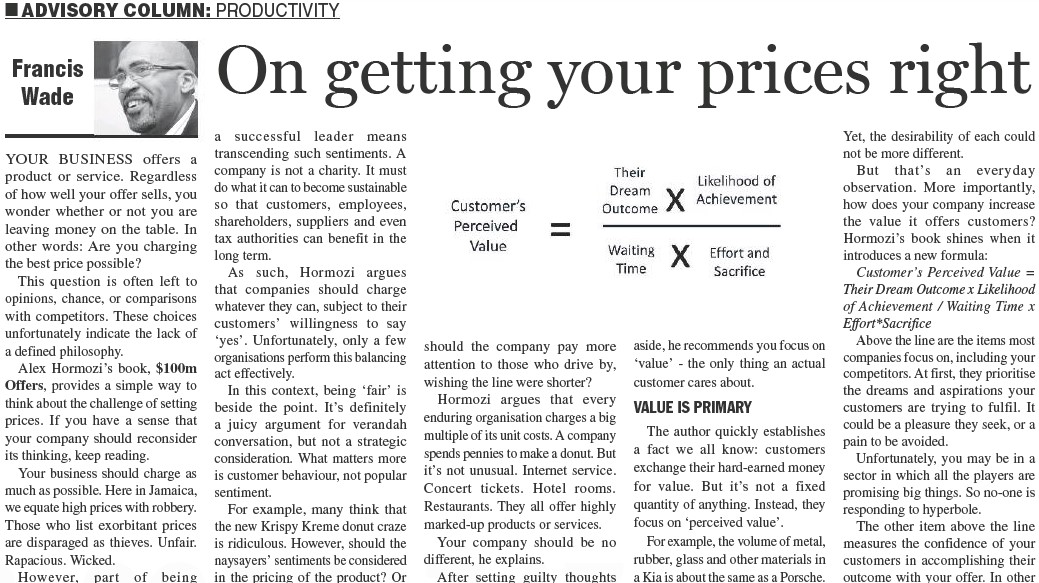Your business offers a product or service. Regardless of how well your offer sells, you wonder whether or not you are leaving money on the table. In other words, are you charging the best price possible?
This question is often left to opinions, chance, or comparisons with competitors. These choices unfortunately indicate the lack of a defined philosophy.
Alex Hormozi’s book, $100m Offers, provides a simple way to think about the challenge of setting prices. If you have a sense that your company should reconsider its thinking, keep reading.
Your Business Should Charge As Much As Possible
Here in Jamaica, we equate high prices with robbery. Those who list exorbitant prices are disparaged as thieves. Unfair. Rapacious. Wicked.
However, part of being a successful leader means transcending such sentiments. A company is not a charity. It must do what it can to become sustainable so that customers, employees, shareholders, suppliers and even tax authorities can benefit in the long term.
As such, Hormozi argues that companies should charge whatever they can, subject to their customers’ willingness to say “Yes”. Unfortunately, only a few organisations perform this balancing act effectively.
In this context, being “fair” is beside the point. It’s definitely a juicy argument for verandah conversation, but not a strategic consideration. What matters more is customer behaviour, not popular sentiment.
For example, many think that the new Krispy Kreme donut craze is ridiculous. However, should the naysayers’ sentiments be considered in the pricing of the product? Or should the company pay more attention to those who drive by, wishing the line were shorter?
Hormozi argues that every enduring organization charges a big multiple of its unit costs. A company spends pennies to make a donut. But it’s not unusual. Internet service. Concert tickets. Hotel rooms. Restaurants. They all offer highly marked-up products or services.
Your company should be no different, he explains.
After setting guilty thoughts aside, he recommends you focus on “value” – the only thing an actual customer cares about.
Value is Primary
The author quickly establishes a fact we all know: customers exchange their hard earned money for value. But it’s not a fixed quantity of anything. Instead, they focus on *perceived* value.
For example, the volume of metal, rubber, glass and other materials in a Kia is about the same as a Porsche. Yet, the desirability of each could not be more different.
But that’s an everyday observation. More importantly, how does your company increase the value it offers customers? Hormozi’s book shines when it introduces a new formula.
Customer’s Perceived Value = Their Dream Outcome x Likelihood of Achievement / Waiting Time x Effort*Sacrifice
Above the line are the items most companies focus on, including your competitors. At first, they prioritize the dreams and aspirations your customers are trying to fulfil. It could be a pleasure they seek, or a pain to be avoided.
Unfortunately, you may be in a sector in which all the players are promising big things. So no-one is responding to hyperbole.
The other item above the line measures the confidence of your customers in accomplishing their outcome with your offer. In other words, a teacher who is famous for gaining government scholarships for PEP will provide more perceived value than a first-timer to the classroom.
These two items in the equation are taught in Marketing 101. However, the biggest differentiators in your niche are probably lying quietly below the line. They sit outside the control of marketers.
Focus Below the Line
As you see from the equation, maximising value means lowering the items underneath the line. The first, the time delay, is the gap between the moment when the customer pays and the moment when the first benefit is experienced. When you lower this interval, value increases.
To illustrate, back in 2001, cell service via Cable and Wireless took weeks to provide. Then came Digicel with its immediate availability, and it quickly became the market leader.
If your offer must take a while to deliver the final outcome, Hormozi recommends that you set up quick wins along the way. This helps customers see and feel progress.
The other item to be decreased below the line is the effort and sacrifice the customer needs to invest. In the book, the author lists liposuction as a means to lose weight, compared with the typical remedy of diet and exercise.
The personal changes required by the latter are considerable. Why? It’s hard to transform one’s habit patterns, attitudes, scheduling, grocery shopping and more. By comparison, for those who can afford it, liposuction only requires a week or two of soreness.
Increasing value for your customers means focusing on each item separately. Do this in your next strategic planning retreat and your prices could be transformed.

